Les poètes et les genres - in english
« Nous t’estimons une Déesse,
Chere Grenouille, qui sans cesse
Au fonds des ruisselets herbeus
Te desalteres quand tu veus »
Pierre de Ronsard, La Grenouille, à Rémy Belleau
The great literary groundswells reach out to the apparent serenity of the garden, to the point of suggesting, as in labyrinths, a moral purpose illustrated by dangerous bewitchments. Ariosto (1474- 1533), for example, shows us the lovers of the magician Alcine transformed into trees by her spells (Orlando furioso, Canto VI).
The poetic material far exceeds the limits of genre, while the garden imposes a poetic climate on works that are formally not poetic, such as the highly influential Songe de Poliphile, printed in Venice in 1499, whose pavilions of greenery shelter figures and enigmas. And it's thanks to an intense poetic memory that Miguel de Cervantes (1547-1616), in his novel Persiles y Sigismunda, regenerates the imaginary world of gardens.
In the beginning, God created the world as a garden, in the infinitely large as in the infinitely small. In the circle of the Pléiade, Pierre de Ronsard (1524-1585) and Rémy Belleau (1528-1577) correspond and compete in emphasis, one in honor of the frog, the other in glory of the snail. The magnifying glass effect on these small, familiar inhabitants contrasts with grand flights of fancy, as the gardener's art transfigures nature and rethinks the universe.
In new lyrical and dramatic forms such as the pastoral, much appreciated by Italian courts in the late 16th century in works like Tasso's Aminta and Guarini's Pastor Fido, the conventions of a supposedly wild environment reinvent the pleasures and surprises of the garden.

